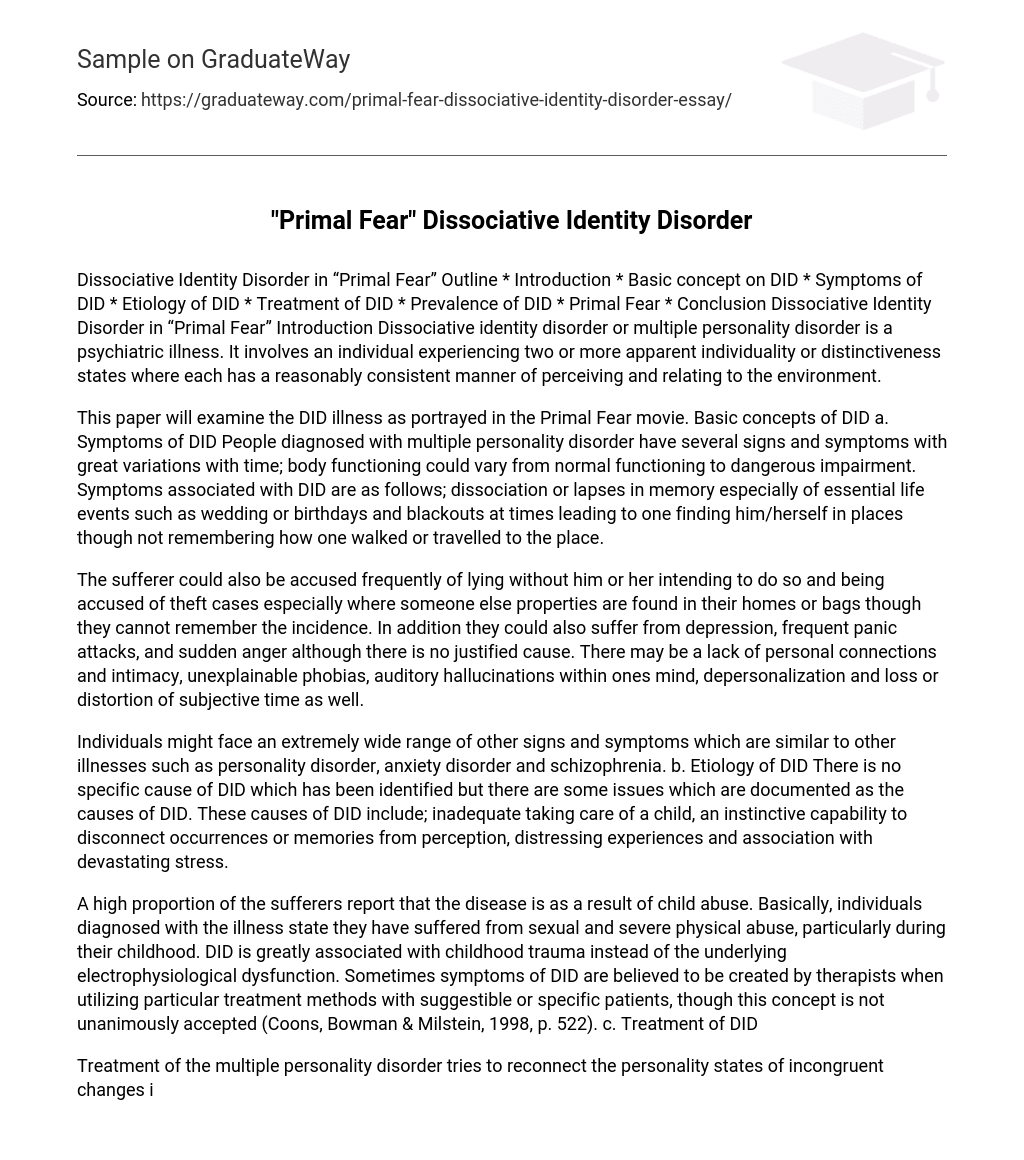Dissociative identity disorder, which is also referred to as multiple personality disorder, is a mental health condition marked by the existence of two or more separate identities. Each identity maintains a consistent manner of perceiving and engaging with their environment.
This paper will analyze the portrayal of the DID illness in the movie Primal Fear. It will explore the basic concepts of DID, including the symptoms associated with the disorder. People diagnosed with multiple personality disorder exhibit various signs and symptoms that can fluctuate over time. The functioning of their body can range from normal to severely impaired. Some common symptoms of DID include dissociation or lapses in memory, particularly of significant life events like weddings or birthdays. In some cases, individuals may experience blackouts and later find themselves in unfamiliar places without any recollection of how they got there.
Individuals may also face frequent allegations of unintentional dishonesty and being implicated in theft incidents. This is especially evident when others’ possessions are discovered in their residences or bags, even though they have no recollection of the event. Moreover, they might confront feelings of sadness, sudden panic attacks, and unexplained bursts of anger. They may also encounter difficulty forming personal relationships and experiencing intimacy, unfounded fears, hearing voices inside their thoughts, a sense of detachment from oneself, as well as an altered perception of time.
Individuals may exhibit a range of signs and symptoms resembling those seen in various disorders, such as personality disorder, anxiety disorder, and schizophrenia. The exact cause of Dissociative Identity Disorder (DID) remains unknown, but certain factors have been identified as possible causes. These factors include childhood neglect, a natural ability to dissociate from memories or events, traumatic experiences, and exposure to intense stress.
Many sufferers of DID attribute the disease to child abuse. They claim to have experienced both sexual and severe physical abuse, particularly during their childhood. Instead of an electrophysiological dysfunction, this disorder is strongly linked to childhood trauma. Some argue that therapists may inadvertently create symptoms of DID through certain treatment methods with suggestible or specific patients, but this idea is not universally accepted (Coons, Bowman & Milstein, 1998, p. 522).
The goal of treating multiple personality disorder is to unite the different personality states into one functioning identity. Additionally, treatment aims to address the symptoms and alleviate distress, ensuring the person’s safety. Common treatment approaches include a combination of medication and psychotherapy. Some healthcare professionals prefer behavioral treatments that involve responding to one personality state and utilizing more traditional therapy when a consistent response is established.
The recovery process for multiple personality disorder is gradual and varies over time. Those with dissociative disorder symptoms and post-traumatic stress disorder characteristics usually respond well to medication or treatment. However, individuals with eating disorders, anxiety disorders, and mood disorders may experience a slower and more complex recovery process. The prognosis for those still connected to their abusers is particularly poor; long-term treatment focuses on relieving symptoms rather than integrating the individual’s personality. The prevalence of multiple personality disorder has significantly increased due to potential misdiagnosis as other mental illnesses like bipolar disorder or schizophrenia. Additionally, there are more cases of child abuse and increased awareness of the disorder leading to earlier and more accurate diagnoses.
In the film “Primal Fear,” two main characters named Martin Vail and Aaron Stampler are involved in a crime where one defends the guilty party. Edward Norton portrays Aaron Stampler, who shows symptoms of Dissociative Identity Disorder (DID) as the accused offender responsible for allegedly killing the archbishop. Despite admitting to being with the archbishop during the murder, Norton’s character claims to have blacked out and believes that an unknown person must have committed the crime.
In this incident, Vail defends Aaron and starts to believe in his client’s innocence. However, Vail also discovers that his client had suffered sexual abuse from the archbishop and that the archbishop’s decisions caused financial losses for civic leaders in real estate investments. Vail recognizes that presenting this evidence could make the jury more sympathetic towards Stampler and provide a possible motive for the crime.
It is clear that the attorney in this case is facing a difficult situation. There is strong evidence against his client, and the public believes the client to be guilty (Gartner, 1999, pp. 253-628). When the attorney confronts Aaron about the offense and accuses him of lying, symptoms supporting his disorder become evident. At this moment, Stampler has a breakdown and assumes a new personality known as ‘Roy’, an aggressive sociopath. Later on, he confesses to murdering the archbishop and physically assaults Vail by throwing him against a wall.
Stampler’s lack of memory when faced with a halt in the situation is confirmed by a psychiatrist who diagnoses him with Dissociative Identity Disorder (DID), attributing it to childhood abuse, especially from his father (Gartner, 1999, pp. 253-628). Instead of receiving treatment, Stampler is immediately sent back to his cell. This pattern repeats itself during court arguments and accusations, where Stampler transforms into his alter ego, Roy, and makes violent threats (Gartner, 1999, pp. 53-628). The most effective medication for Stampler would have been psychotherapy as it could help improve his interpersonal relationships and address uncomfortable emotions from his past. Additionally, this form of treatment would prevent overwhelming anxiety and the reemergence of traumatic experiences triggered by intense emotions. Ultimately, DID is characterized by the presence of two or more distinct personalities.
Brown, Frischholz, and Scheflin (1999) noted that Aaron Stampler in the film Primal Fear displays traits of Dissociative Identity Disorder (DID), including time blackouts, memory lapses, and feelings of unreality. Childhood trauma is identified as the primary catalyst for this condition, encompassing both physical and mental experiences. Coons et al. (1998) propose various treatment possibilities for DID such as medications, psychotherapy, and hypnosis.





